Posted by Elena del Valle on August 27, 2012
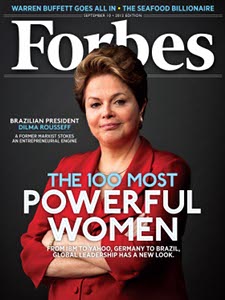
Forbes 100 Most Powerful Women cover
Photo: Forbes
For nine years Forbes has compiled a list of 100 Most Powerful Women around the world. German Angela Merkel was at the top followed by Hillary Clinton in this year’s recently released list. The cover is occupied by Dilma Rousseff, president, Brazil and number three on the list. The magazine dedicated pages 64 to 69 to her. Of the top ten women on the list six are from the United States and there is at least one Latina, Jennifer Lopez in the Celebrity category, among the 100 influential women from around the globe. She appears in the thirty eighth spot.
Some Latinas like Shakira and Sofia Vergara among the celebrities and several in other categories who United States audiences may recognize appear on the list but they are listed in the country where they reside. In the case of Shakira and Sofia Vergara that is Colombia. While 28 countries are represented 61 of the women reside in the United States.
Although there is no list of most powerful men there is a list of Most Powerful People due to be released later this year. A spokesperson declined to identify “how much time it takes to report for our lists.”
For this year’s list the publication selected the 100 most influential women from seven categories or power bases: billionaires, business, lifestyle (including entertainment and fashion), media, nonprofits/NGOs, politics and technology. Staff assigned the rank within each category, as well as overall rank on the list of 100, by applying three metrics: money, media presence and impact.
For the money metric, the staff took into account 2011 company revenue and market value if it was available for business, media and tech; for lifestyle salary, they relied on the Forbes 2012 Celebrity 100; for GDP, politics and net worth they looked at the Forbes 2012 World’s Billionaires list for those with 10-figure bank accounts; and women from nonprofits/NGOs were rated on dollars spent fulfilling the organization’s mission.
They took into consideration media component accounts for news hits (Factiva) and TV and radio appearances (Nexis) from the past 12 months, as well as number of followers on social media channels Facebook, Twitter and YouTube as of July 2012. They scored candidates on their impact including “the extent of their reach across industries, cultures and countries, the number of spheres of influence and people they affect and how actively they wield their power.”
The top names from the United States were: Hillary Clinton, Secretary of State, United States; Melinda Gates, co-chair, Bill & Melinda Gates Foundation; Jill Abramson, executive editor, New York Times Co.; Michelle Obama, first lady, United States; Janet Napolitano, secretary, Department of Homeland Security, United States; Sheryl Sandberg, COO, Facebook; Oprah Winfrey, entrepreneur; Indra Nooyi, chairman and CEO, PepsiCo; and Irene Rosenfeld, chairman and CEO, Kraft.
Posted by Elena del Valle on August 20, 2012
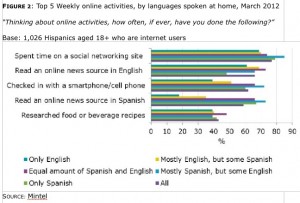
Hispanics Top 5 weekly online activities – click to enlarge
Graphic: Mintel
Hispanics spend an average of $150 per month on entertainment products and activities; and Latino families who earn between $50,000 and $74,900 a year are more likely to spend less than $100 per month on entertainment, according to a Mintel survey of adults conducted in March 2012. In general, the results of the survey reveal that that market segment is being frugal and thrifty in its entertainment spending. For many Hispanics cost plays a major role in their decisions about entertainment, according to the survey.
“Due to financial restraints, Hispanics are enjoying more in-home activities rather than spending their discretionary funds on out-of-home paid events,” said Adam Jacobson, multicultural analyst, Mintel. “Watching a movie on TV or reading a book or magazine is taking a front seat to more financially-driven experiences, such as dining out or going to live sporting events.”
A little more than one third (36 percent) of Latino respondents to the Mintel survey indicated they watch a movie on TV more than three times per week. One third of respondents said they like to read a book or magazine in Spanish; 40 percent of Hispanics said they like eating out one to three times per month; 34 percent said they attend a sporting event, and 30 percent said they planed to attend a street festival in the next three months.
For Latinos going out dining and the movies were popular entertainment options. More than half (53 percent) of respondents said they had seen a feature film in a theater at least once in the last year and 42 percent said they planned to go to the movies in the following three months.
Mintel researchers concluded that movie theaters might benefit from targeting Latino movie goers with concession items that appeal to Hispanics or family discount programs since as a group Hispanics tend to have larger families than non-Hispanics.
Another form of in home entertainment was online surfing. Many (77 percent) survey respondents said they connect with friends on social networking sites such as Facebook or Myspace. More than one third (36 percent) of Hispanic adults who took the survey said they visit their social networking websites thrice a day or more often using mobile devices. More than half (65 percent) of Latino survey takers who spent time online said they have a smartphone, and 31 percent said they have an iPad or tablet.
Although language preference didn’t seem to impact the amount of money respondents said they spent on entertainment, the percent of monies available varied by gender. Hispanic women said they were spending 40 percent less on entertainment than Hispanic men, regardless of their household income. Volunteerism was not popular among survey respondents regardless of their income level.
Information about the report, Hispanics and Entertainment US June 2012, was released this month. The survey was conducted among 1,026 adults online and respondents had the option to take it in English or Spanish. The complete 124-page report costs $3,995.
Posted by Elena del Valle on August 6, 2012

Top institutions awarding certificates/degrees to Latinos in STEM 2009 to 2010 by academic level – click to enlarge
Latinos earned only few (8 percent) certificates and degrees in Science, Technology, Engineering, and Mathematics (STEM) mostly from 25 institutions of higher learning, according to a recent Excelencia in Education report released last week. Excelencia, a nonprofit organization, strives to accelerate higher education success for Latino students.
“This analysis is straightforward: we know where Latinos are earning their degrees in STEM and we know what some of these institutions are doing, with intentionality, to improve Latino success in STEM fields,” said Deborah Santiago, author of the report and co-founder, Excelencia in Education. “What we need to determine now is whether more institutions and more employers will seize the opportunity to educate and employ more Latinos in professional STEM fields.”
In 2011, Latinos in the STEM workforce were more likely to be in lower paying service occupations such as electrical, electronics, and electromechanical assemblers, telecommunications line installers and repairers, and aircraft mechanics and service technicians rather than better paid professional occupations such architectural and engineering managers and computer and information systems managers.
Since the average age of Hispanics is lower than that of the general population and there is a high number of Latinos entering the workforce the findings are significant. The Executive Summary of the report indicates: “Given the relative youth of the Latino population relative to the aging of the u.s. population overall, supporting the increased growth of Latinos with postsecondary credentials in sTeM is critical to meeting the projected workforce needs of the nation by 2020.”
In 2009 to 2010, the top 25 institutions awarding undergraduate degrees or certificates to Latinos in STEM were in Texas, Florida, California, Arizona, Illinois, New Mexico and Puerto Rico. That same year, 60 percent of degrees conferred to Latinos in the science and related files were bachelor degrees, making those students most likely to enter service occupations in their chosen fields.
The 37-page report, Finding Your Workforce: The Top 25 Institutions Graduating Latinos in Science, Technology, Engineering, and Mathematics (STEM) by Academic Level (2009-10), was authored by Santiago, vice president for policy and research, and Megan Soliz, research assistant, Excelencia.
Posted by Elena del Valle on July 25, 2012

Fewer young people are obtaining a driver’s license, according to researchers at University of Michigan Transportation Research Institute
Photo: HispanicMPR.com
Research conducted by Michael Sivak and Brandon Schoettle of the University of Michigan Transportation Research Institute, Ann Arbor, Michigan indicates again that fewer young people, compared to previous decades, are obtaining a driver’s license. The researchers reviewed driver license and general population information from the Federal Highway Administration and the United States Census Bureau to find that the trend they had identified in the past continues. As an example, they point to drivers 19 years of age. Their findings indicate 87.3, 75.5, and 69.5 percent of these individuals had a driver’s license in 1983, 2008, and 2010 respectively.
“The most significant aspect of our findings is that the trend that we observed in a previous study is continuing,” said Sivak by email. “Specifically, young and middle-aged persons are less likely to get a driver’s license now than were the corresponding age groups 30 years ago. We think that the availability of electronic communication has a lot to do with this trend.”
Earlier this year (see Older adults more likely drivers than in past decades), after examining data for 1983 to 2008 in the United States and 14 other countries they concluded there was a noticeable decrease in the percent of young people obtaining a driver’s license and an increase in the percent of older people with one. They have since examined additional data in the United States through 2010 that indicates the trend continues for young people and that there is a reduction in the proportionate number of driver’s licenses across age groups.
They still believe the trend relates inversely to the continued increase in internet usage. They concluded that the more people rely on the internet for contact the less they require in person contact.
It’s unclear whether the trend applies to all market segments. Hispanics which as a market are younger than the general market may be affected. A Ford Motor Company representative when asked about the trend responded negatively.
“For Hispanic consumers cars are a symbol of freedom, accomplishment and status,” said Alvaro Cabal, manager, Multicultural Communication, Ford Motor Company.
Except in cities with efficient mass transportation systems like New York and Washington, D.C., the research findings are not in evidence in car buying behavior, he explained by phone. He went on to say that since the 2008 recession when car sales dropped the company has experienced a steady increase in car purchases, especially among 18 to 45 year old buyers.
Posted by Elena del Valle on July 18, 2012
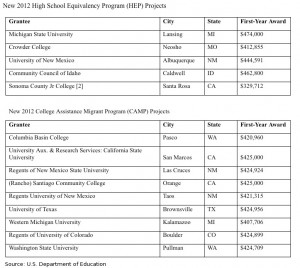
Click to enlarge
Photo, chart: U.S. Secretary of Education
Targeting migrant students and their families? You may be interested to know that the U.S. Department of Education awarded $5.9 million to 14 grantees in nine states for education for high school and college students migrant or seasonal farm workers, or the children of such workers. The five-year grants are awarded under the High School Equivalency Program (HEP) and the College Assistance Migrant Program (CAMP) through the Department’s Office of Migrant Education said to serve 5,000 HEP and 2,000 CAMP students annually.

Arne Duncan, U.S. Secretary of Education
“The students helped by HEP and CAMP are some of the most motivated learners in America,” said Arne Duncan, United States Secretary of Education. “These grants will help hardworking farmworkers and their families obtain the quality education that they need to compete in the 21st century global economy.”
The purpose of the HEP grants is to help migrant and seasonal farmworkers, and members of their immediate families obtain general education diplomas that meet the guidelines for high school equivalency established by the state in which the HEP project is conducted. The program helps migrant youth gain employment or placement in an institution of higher education or other postsecondary education or training via counseling, job placement, health care and housing for residential students.
CAMP grants support students who are migratory or seasonal farm workers, or the children of such workers, during their first year of undergraduate studies and to continue in postsecondary education. The mission of the Office of Migrant Education (OME) is to “provide excellent leadership, technical assistance, and financial support to improve the educational opportunities and academic success of migrant children, youth, agricultural workers, fishers, and their families.”
Posted by Elena del Valle on June 27, 2012
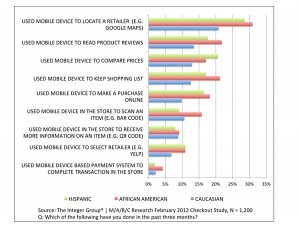
African Americans, Hispanics adopting mobile shopping behaviors – click to enlarge
Photos, chart: Network Communications
With the increasing popularity of smartphones (mobile phones that combine the features of a cell phone and a computer) and mobile devices marketers want to know if mobile buying behaviors are prevalent among the owners of these gadgets. Estimating that smartphone penetration is nearing 50 percent in the United States, in February 2012, The Integer Group and Marc Research surveyed 1,200 people online, in English, as part of an ongoing shopper behavior study.
One of the salient findings of their survey was that African American and Hispanic shoppers who participated in the survey appear to adopt shopping technologies at a faster rate than Caucasian (non Hispanic white) respondents. Among survey takers 18 percent of African American shoppers and 16 percent of Hispanic shoppers said they use their mobile device to make purchases compared to 10 percent of non Hispanic whites.

Martin Ferro, senior account planner, Velocidad
One in five African American shoppers (21 percent versus 13 percent of Caucasian shoppers) said they use their phone to read product reviews and maintain shopping lists, and one in five Hispanic shoppers (20 percent versus 13 percent of Caucasian shoppers) said they use their mobile device to compare product prices. The researchers believe that in spite of lower smartphone penetration among African Americans and Hispanics than Caucasians, the two ethnic groups, and women shoppers in particular, are using mobile phones as shopping aids.
“Basic mobile communication through SMS and mobile websites should be the points of entry. Mobile marketing to multicultural shoppers is a huge opportunity,” said Martin Ferro, senior account planner, Velocidad, a Hispanic promotional, retail and shopper marketing capability of The Integer Group.

Ben Kennedy, group director of Mobile Marketing, Integer
The survey also revealed that nearly as many shoppers said they are using coupons from email and e-newsletters (49 percent) as said they are from the Sunday paper (57 percent). Respondents in households with children seemed more likely to overcome adoption barriers of digital technologies in favor of shopping solutions.
“Digital shoppers are just shoppers,” said Ben Kennedy, group director, Mobile Marketing, Integer. “Digital shopping tools are illustrative of the continued blurring of the on- and offline spaces. Today’s reality is that shoppers use whatever tools they have on hand to make them smarter, savvier shoppers.”
In the surveys, consumers were asked about their shopping attitudes, shopping behaviors, and economic outlook as well as the criteria shoppers use to select retailers, which in-store stimulus is most likely to drive purchase, and factors that might lead shoppers to leave an aisle empty-handed.
The Integer Group is a large promotional, retail, and shopper marketing agency, and a member of Omnicom Group Inc.
Posted by Elena del Valle on June 20, 2012
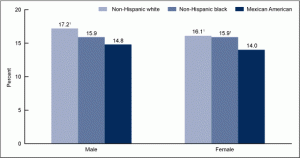
Sugar consumption children and adolescents 2005-2008 – click to enlarge
Chart source: CDC/NCHS, National Health and Nutrition Examination Survey, 2005–2008, CDC.gov
Restaurant owners, food makers and sellers listen up. Insufficient exercise, fatty and sweet foods were among the top concerns of Hispanic respondents to a November 2011 survey question by Mintel, a consumer, product and media intelligence company, about poor health.
Other concerns included eating too many processed foods as well as foods with too many calories or too much salt. The results of the survey of two thousand adults were released in Attitudes Toward Sodium US February 2012, a report by Mintel. The survey did not indicate if the respondents planned to take any action to modify their exercise regime or eating habits.
While Hispanic households spend less than mainstream households in general due to the larger size of Hispanic households (3.3 people compared to 2.5 people in the average non Hispanic home) Hispanics spend as much on groceries as the average household, according to Who We Are: Hispanics Second Edition (see Book outlines Hispanic population major characteristics).
It’s not clear whether the beliefs expressed by the Mintel survey takers are based on facts or perceptions and whether they apply only to adults. A study that used data from the National Health and Nutrition Examination Survey examined sugar consumption of United States children and adolescents between 2005 and 2008 (see Consumption of Added Sugar Among U.S. Children and Adolescents, 2005–2008 at CDC.gov and Mexican-American children eat less sugar than peers, says new study on NBC Latino) and indicated that Mexican American children “eat a smaller percent of calories from added sugars than their non-Hispanic white and non-Hispanic black peers.”
Posted by Elena del Valle on June 18, 2012

Melinda Lee, director, Getty Images Music
Photo: Getty Images Music
Getty Images, a leading creator and distributor of still imagery, video and multimedia products, as well as a provider of other forms of digital content including music with business customers in more than 100 countries, hopes to sell music to executives in the Hispanic advertising industry which the company’s executives believe represents more than a $5 billion industry. Getty marketing staff believe Spanish-language indie music is a “significant and largely unknown super-genre” that is growing “immensely in popularity and penetrating mainstream markets.”
Getty Images Music in partnership with MuuseMe is targeting United States content creators who service the Hispanic programming and advertising industry, the local Spanish language market, Latin America, Mexico and other Spanish speaking countries. The content creators in the United States represent about 75 percent of their target audience, according to a spokesperson.
“We’re committed to offering an affordable solution to this growing market, so that it can continue to grow without budgetary or creative limitations,” said Melinda Lee, director, Getty Images Music by email.
“The forward thinking team at Getty Images Music really gets what we’re trying to do here at MuuseMe,” said Rob Filomena, co-founder, MuuseMe. “Their international network allows us to offer our content partners multi-platform placement opportunities, and stay at the forefront of an important cultural trend by creating the first ever Spanish-language Indie production library.”
Getty Music has over 200,000 tracks. Through the partnership it will acquire an additional 3,000 tracks for a total of 10,000 Spanish language tracks when combined with its existing Spanish and Latin American catalog with Spanish-language indie music and indie bands that have Hispanic influences to be licensed through single and multiple track licenses, blankets and customized offerings by project. Price will be project and use based.
“We are promoting this highly valuable offering through media outreach efforts, on Getty Images digital platforms, social media and through our global sales and marketing force. We already know that our existing clients need this music so we are committed to getting the music to them,” said Lee in response to a question about channels the company is relying on to promote its new product line.
Examples of tracks that are available in the new collection include Plastics Revolution (Mexico), La Bien Querida (Spain) and Palenke Soultribe (Colombia). In addition to Getty Images Music’s existing Spanish and Latin American catalog with Spanish language indie music, the offering also includes English language indie bands that have Hispanic influences; and well-known Spanish and Latin American artists who are breaking into the United States market, according to Lee.
Posted by Elena del Valle on June 13, 2012
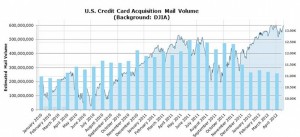
Direct mail credit card offers – click to enlarge
Chart: Mintel Comperemedia
Some researchers believe credit card offers are a reflection of the economic health of the country. In June 2011, there were 497 million credit card direct mail offers nationwide, a healthy number. By April of 2012 the number was down to 260 million, reflecting a 33 percent drop in direct mail offers for new credit cards between April 2011 and April 2012. In other words in April of this year, United States households received an estimated 260 million credit card offers while a year earlier they received 390 million offers. This may be the lowest estimated monthly mail volume tracked in the past 25 months, according to Mintel Comperemedia.
“Issuers have adopted a more cautious approach due to an uncertain economic environment. The latest downturn likely reflects a pause in activity rather than signifying a permanent reduction in direct mail,” said Andrew Davidson, senior vice president at Mintel Comperemedia. “Credit card direct mail volume will be significantly lower in 2012 than 2011. For credit card issuers this is a great time to be in the mail. The mailbox is less cluttered and it is easier to get consumers to notice your message.”
Because direct mail offers for credit cards are cyclical mailings likely reflect market trends and Dow changes, and since other marketing channels, such as online and social media, are not replacing direct mail the mailings are likely to return to high levels once the economy recovers, he believes.
Posted by Elena del Valle on June 11, 2012
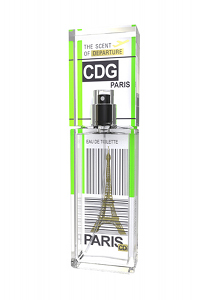
The Scent of Departure Paris
Photos: The Scent of Departure
Ever want to visit Singapore, Budapest or Istanbul but didn’t get a chance? Or perhaps you visited those exotic cities and want to reminisce about your trip? A new perfume line, launched in 2011, promises scent lovers the essence of those cities and 17 others including three in the United States in a $45 1.7 ounce bottle. If blood orange, sweet orange, lemon, yellow tangerine, pink grapefruit, lotus flowers, freesia, lilac, orange jump, white musk, blonde wood, vanilla, and caramel remind you of Miami you are in luck. Those are the ingredients in the line’s Miami eau de toilette fragrance.
Caramel can also be found in New York if the perfume makers are to be believed. In addition to caramel they made that city’s namesake fragrance with green and crispy apple, juicy apple, lotus flower, jasmine, lilac, rose petal, caramelized apple, white musk, and vanilla. Tokyo on the other hand smells like lemon, bergamot, green stem, lotus flower, freesia, ozonique flowers, peony and white musk, according to them.
This could be a good time to introduce such a line, allowing it to be in place for the year’s Christmas holidays which, according to Mintel, is when most perfume buying takes place in the country. Perfumes and products with fragrances seem to be popular among United States consumers. In a survey last year, many (29 percent) domestic consumers said they bought someone a fragrance (25 Stocking Stuffers from Mintel, Holiday Shopping U.S. July 2011 and Seasonal Chocolate U.S. August 2011 Mintel survey reports). In 2005, the average annual consumer spending of Consumer Units (there were 2.5 persons per Consumer Unit; Consumer Unites appear in 000s) on cosmetics, perfume and bath products was 132.31 (Household Spending 12 Edition), the highest segment by far of the Personal Care Products category.

Magali Senequier and Gerald Ghislain
Gerald Ghislain, perfumer, and Magali Senequier, his creative partner, used the IATA (International Association of Travel Agents) assigned three letter airport codes for 20 cities to name The Scent of Departure line which, according to a company spokesperson, is made in Paris, France. They selected cities they had visited and liked for the line targeted at “men and women who love to travel or discover trendy and atypic products,” according to the spokesperson. Prior to this line they launched Histoires de Parfums.
The fragrance is contained in a slender glass bottle sporting the letters for that city with a design inspired by a luggage tag with the three IATA code letters of the city that it represents. The initial scents are: Paris (CDG), London (LHR), Milan (MIL), Frankfurt (FRA), Munich (MUC), Keflavik (KEF), Istanbul (IST), Budapest (BUD), Vienna (VIE), New York (NYC), Los Angeles (LAX), Miami (MIA), Dubai (DXB), Abu Dhabi (AUH), Doa (DOH), Singapore (SIN), Tokyo (TYO), Hong-Kong (HKG), Seoul (ICN) and Bali (DPS). The company plans to sell the line at airports, large retail stores, Henri Bender in New York and at its website, thescentofdeparture.com.
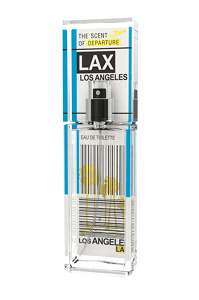
The Scent of Departure Los Angeles
If as Jennifer Dublino, chief operating officer, Scent Marketing Institute, said “Scent is particularly important to Latinos, even more so than to other cultural groups,” (see Scent Marketing Connects to Hispanics on a Deep Cultural Level) this new line could appeal to Latino consumers in the United States and Latin America.
It is noteworthy that the three cities in the United States included in the line, Los Angeles, Miami and New York City, have some of the largest pockets of Latinos in the country. Some might wonder if the inclusion of well liked cities like Paris and London will make up for the absence of Latin American cities in the line. Will the oversight displease United States Latinos? Will Latinas who, according to Dublino, use fragrance products much more frequently than non-Latinas because they are an important part of their feeling of femininity, respond to the marketing concept of the line?
























